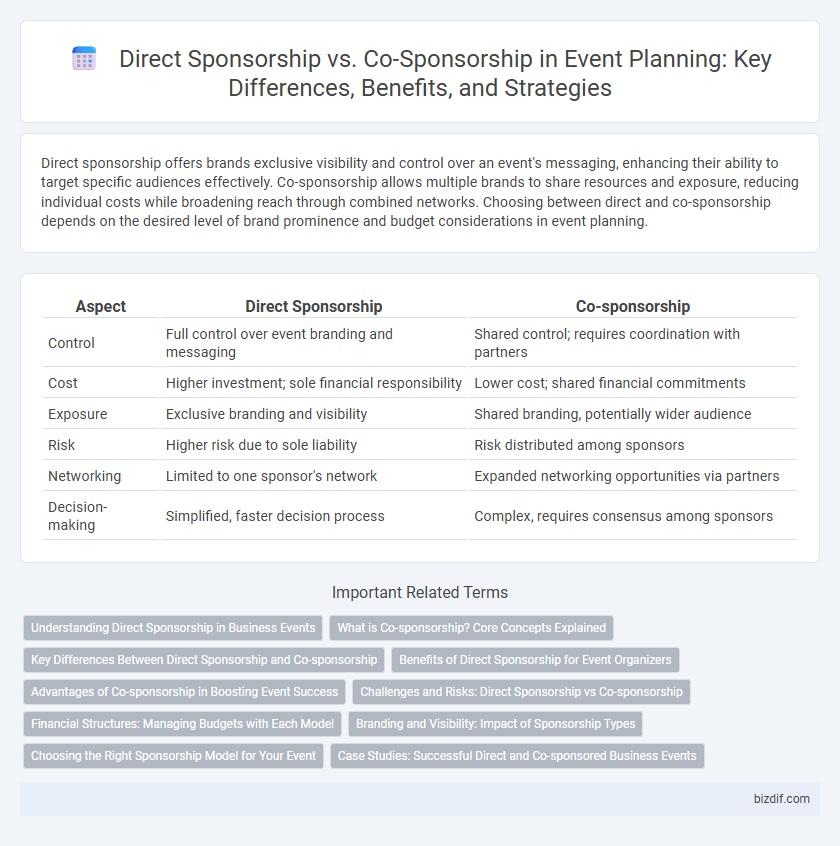Direct sponsorship offers brands exclusive visibility and control over an event's messaging, enhancing their ability to target specific audiences effectively. Co-sponsorship allows multiple brands to share resources and exposure, reducing individual costs while broadening reach through combined networks. Choosing between direct and co-sponsorship depends on the desired level of brand prominence and budget considerations in event planning.
Table of Comparison
| Aspect | Direct Sponsorship | Co-sponsorship |
|---|---|---|
| Control | Full control over event branding and messaging | Shared control; requires coordination with partners |
| Cost | Higher investment; sole financial responsibility | Lower cost; shared financial commitments |
| Exposure | Exclusive branding and visibility | Shared branding, potentially wider audience |
| Risk | Higher risk due to sole liability | Risk distributed among sponsors |
| Networking | Limited to one sponsor's network | Expanded networking opportunities via partners |
| Decision-making | Simplified, faster decision process | Complex, requires consensus among sponsors |
Understanding Direct Sponsorship in Business Events
Direct sponsorship in business events involves a single company funding and owning primary rights to brand exposure, allowing for exclusive marketing opportunities and targeted audience engagement. This approach enables the sponsor to control event messaging, integrate brand identity seamlessly, and maximize return on investment through tailored activations. Companies leveraging direct sponsorship achieve heightened visibility, stronger customer loyalty, and measurable impact on sales and brand awareness.
What is Co-sponsorship? Core Concepts Explained
Co-sponsorship involves two or more organizations jointly supporting an event, sharing resources, costs, and promotional responsibilities to maximize reach and impact. This collaborative approach enhances credibility, broadens audience engagement, and distributes financial risk among partners. Core concepts include aligned brand values, clearly defined roles, and mutual benefits in marketing and networking opportunities.
Key Differences Between Direct Sponsorship and Co-sponsorship
Direct sponsorship involves a single sponsor providing exclusive financial or material support to an event, ensuring sole branding and control over promotional activities. Co-sponsorship shares these responsibilities and benefits among multiple sponsors, leading to joint marketing efforts and divided visibility. Key differences include the level of exclusivity, budget contribution, decision-making authority, and brand exposure, with direct sponsorship offering more concentrated influence compared to the collaborative nature of co-sponsorship.
Benefits of Direct Sponsorship for Event Organizers
Direct sponsorship provides event organizers with greater control over branding, messaging, and activation strategies, ensuring a cohesive event experience. This approach also maximizes revenue potential by eliminating the need to share sponsorship funds, allowing organizers to reinvest in event quality and growth. Direct sponsorship relationships foster stronger partnerships, enabling tailored collaboration and long-term support.
Advantages of Co-sponsorship in Boosting Event Success
Co-sponsorship leverages combined brand recognition and resources, significantly enhancing event visibility and attendee engagement. Sharing costs and responsibilities reduces financial risk while enabling access to a broader network and diverse marketing channels. Collaborative promotion and expertise contribute to a more dynamic and well-executed event, increasing overall success and ROI.
Challenges and Risks: Direct Sponsorship vs Co-sponsorship
Direct sponsorship centralizes control over event branding and execution but presents risks such as higher financial liability and sole accountability for unforeseen challenges. Co-sponsorship distributes financial burden and diversifies audience reach while complicating decision-making processes and increasing potential conflicts over brand representation. Both approaches require careful risk assessment to balance control, cost, and collaborative challenges effectively.
Financial Structures: Managing Budgets with Each Model
Direct sponsorship typically involves a single sponsor providing full financial support, allowing clearer budget control and straightforward accounting for event planners. Co-sponsorship distributes costs and financial risks across multiple sponsors, requiring more complex budget management and detailed agreements to allocate expenses and returns accurately. Effective financial structures in each model impact cash flow, resource allocation, and overall event profitability.
Branding and Visibility: Impact of Sponsorship Types
Direct sponsorship offers exclusive branding opportunities, ensuring the sponsor's logo and messaging dominate event materials, enhancing brand recall and visibility. Co-sponsorship divides exposure among multiple brands, potentially diluting individual impact but fostering shared audience reach and collaborative promotion. Choosing between direct sponsorship and co-sponsorship affects brand prominence, audience perception, and long-term marketing benefits in event planning strategies.
Choosing the Right Sponsorship Model for Your Event
Selecting the right sponsorship model for your event depends on your goals, budget, and target audience engagement. Direct sponsorship offers exclusive branding opportunities and greater control over sponsor activation, ideal for high-profile events seeking a single major partner. Co-sponsorship spreads costs and expands reach by leveraging multiple sponsors' networks, beneficial for events aiming to diversify funding and increase collaborative marketing efforts.
Case Studies: Successful Direct and Co-sponsored Business Events
Case studies reveal that direct sponsorship often yields greater brand visibility and control, exemplified by Salesforce's Dreamforce, which leveraged sole sponsorship to enhance customer engagement and generate $200 million in revenue. In contrast, co-sponsored events like the Web Summit, supported by multiple technology giants, successfully share costs and diversify audience reach, resulting in a 50% year-over-year increase in attendee participation. These examples underscore how direct sponsorship suits brands seeking exclusive association, while co-sponsorship benefits those aiming for collaboration and expanded network effects.
Direct sponsorship vs Co-sponsorship Infographic

 bizdif.com
bizdif.com